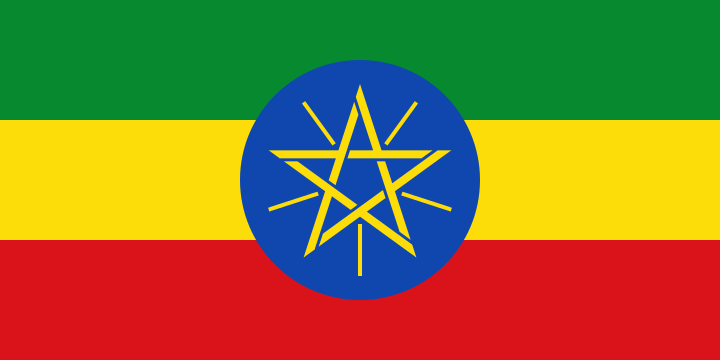Positioned at the zenith of the flag, the green stripe eloquently embodies Ethiopia's fertile lands and venerable agricultural legacy. It is a living emblem of the nation's potential for unfurling growth and flourishing prosperity. Reverberating through time, the Ethiopian Highlands, one of humanity's earliest cradles of cultivated plants and domesticated animals, impart an enduring resonance to this verdant hue. Beyond its literal representation, the green stripe also serves as a potent metaphor for the sowing of hope and the steadfast commitment to sustainable progress.
Yellow Stripe:Nestled between the verdant zenith and the fervent crimson nadir, the middle yellow stripe resonates with profound significance. It eloquently mirrors the intricate mosaic of Ethiopia's populace—a diverse tapestry interwoven with myriad ethnicities, languages, and cultures. This stripe, suffused with the golden glow of unity, attests to the harmonious coalescence of distinct elements into a singular national identity. Beyond mere coexistence, it encapsulates the ethos that, despite the tapestry of differences, the Ethiopian people stand unified as one cohesive entity. Moreover, the yellow stripe's luminescence illuminates the sanctity of peace and the virtue of religious tolerance that Ethiopia has nurtured through epochs of time.
Red Stripe:In the deepest recess of the flag, the crimson stripe speaks eloquently of sacrifice and resolute determination. It serves as a solemn tribute to the indomitable spirit of Ethiopia's sons and daughters who, across epochs, have poured forth their lifeblood to safeguard the sanctity of their land, heritage, and self-sovereignty. This passionate hue bears witness to the crucibles of adversity, including the valiant struggles against colonial incursions, most notably the resolute stand against Italy's incursion in the 1930s. Within its fervent folds, the red stripe perpetuates the enduring memory of these trials and the unwavering resolve of the Ethiopian people throughout their storied history.
Blue Circle:Enshrined at the heart of the flag, the cerulean circle unfurls myriad layers of symbolism. Primarily, it stands as a beacon of peace, serenity, and equilibrium, signifying Ethiopia's unwavering commitment to fostering amicable relations with fellow nations and the tireless pursuit of diplomatic resolutions to conflicts. The azure hue further reverberates beyond borders, extending as an embrace to encompass the entirety of the African continent. Within this azure embrace, Ethiopia's role as a vanguard of unity and collaboration among African nations is gracefully enunciated.
Yellow Pentagram (Star):Adorning the blue embrace, the luminous yellow pentagram—a five-pointed star—resonates with both historical and spiritual import. It intertwines the earthly and divine, encapsulating the profound connection between the Ethiopian Orthodox Tewahedo Church and the state. As one of humanity's oldest Christian bastions, Ethiopia's spiritual heritage has indelibly shaped its societal identity. The pentagram also evokes Ethiopia's historical luminosity and intrepid independence on the African stage—a radiant testament to the nation's resilient stance amidst the tumultuous currents of the "Scramble for Africa."
In summation, the Ethiopian flag stands as an intricately woven tapestry of symbolism, encapsulating the nation's fertile past, its unity amidst diversity, the profound sacrifices borne for freedom, an unwavering dedication to peace, and the profound interplay of faith and history. Each element meticulously etched into its design serves as a vivid chapter, collectively weaving a powerful narrative that reverberates across Ethiopia's past, present, and the tapestry of its future.
Last Updated on: August 01, 2023